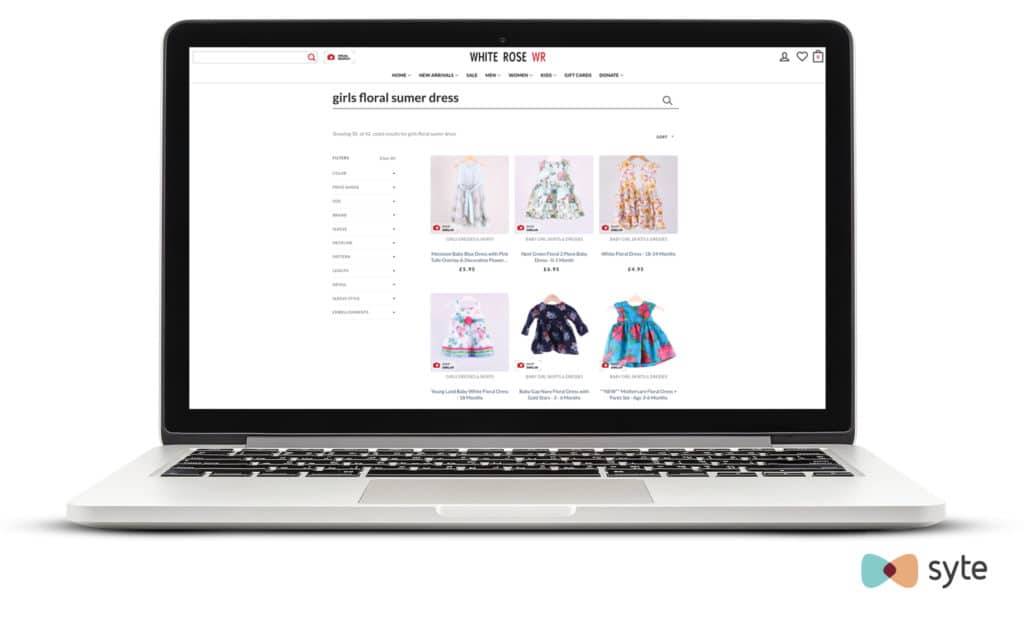Just like traditional in-store merchandising, the way you present, arrange, and display products on your website has a direct impact on the product discovery journey and overall customer experience. When done correctly, it can increase conversions, maximize sales, and build customer loyalty.
In this post, we take a deep dive into the key factors you should consider when planning your eCommerce search and merchandising strategy. Our conversation will focus on how to find and evaluate good searchandising software solutions. We’ll start by defining what searchandising is, why it’s important for brands and retailers, and how it works. Then we’ll go through five key questions that will help you identify the best searchandising solution for your business needs.

What is Searchandising?
Searchandising, or search merchandising, is the strategic organization of search results that empowers retailers to surface relevant products at the most crucial points of the customer journey.
Effective searchandising software will typically use a comprehensive set of AI-powered tools to enhance your customers’ product discovery experience, increase basket size, and boost overall revenue. It’s an ongoing process that allows brands and retailers to arrange, track, evaluate, and optimize product search results in order to reach critical business goals. Equally important, it makes the shopping experience convenient, personal, and memorable for users.
Why is searchandising software so important?
On-site search is one of the many eCommerce features that consumers use to find products and navigate their shopping journeys. Effective searchandising software is a gamechanger because it enables retailers and brands to simplify and enhance site navigation for their customers, which ultimately boosts revenue.
For example, according to Forrester Research, 43% of site visitors go immediately to search bars and successful searchers are 2-3 times more likely to convert than regular users. On the other hand, inefficient site search engines can result in lost revenue — with up to 68% of shoppers leaving a retail site after a poor search experience.
How does searchandising software work?
Effective searchandising software programs typically include three core capabilities:
- Automated product tagging that can detect and assign detailed labels that accurately represent each product. These tags enrich the product metadata which in turn enables brands and retailers to better group and present their products online.
- Sophisticated text search that is powered by artificial intelligence (AI), natural language processing (NLP), and machine learning. These capabilities work together to enable your on-site search engine to understand each customer’s intent, account for spelling and grammar mistakes, recognize synonyms, and more.
- Smart merchandising rules that allow brands to determine how products are grouped, ranked, and presented to online shoppers. These rules enable brands and retailers to promote the right products when and where it matters to shoppers. For example, you can tweak relevance rules so that your site’s search results prioritize products that are relevant to current or seasonal campaigns.
Important Questions to Ask When Evaluating a Searchandising Solution
Good visual merchandising and searchandising is a process that needs constant fine-tuning, A/B testing, monitoring, and evaluation to achieve the desired outcomes. Hence, you need to make sure your investment is worthwhile by picking the right searchandising solution for your website. To help you with this process, we’ve put together five key questions to keep in mind while doing your research.
1. Does it quickly show accurate results?
Before delving into the capabilities of a searchandising solution, it’s important to focus on two non-negotiables: accuracy and speed.
Consumers expect convenience when shopping online, and that includes speed, reliability, and accessibility. When it comes to searchandising, you can address these expectations by delivering product search results that match user search terms, intent, and context. This not only enhances product discovery and customer experience but also ensures customer adoption of your improved on-site search.
Related to accuracy is speed. According to a PwC survey, speed is one of the key customer experience factors that hit 80% in importance to consumers. If you can’t quickly deliver search results, then it defeats the purpose of using a searchandising software solution. Remember, most shoppers no longer have the patience to work around frictions on your site because they can just as easily access plenty of other online options.

UK retailer White Rose Vintage leverages a sophisticated site search solution that enables seamless product discovery experiences despite spelling and grammar errors in the search bar. The built-in NLP can recognize user intent and respond with highly relevant search results that lead to more purchases.
2. Does it offer automatic product tagging?
Online merchandising is a continuous, day-to-day process, and for it to be efficient, it must be paired with a robust product tagging system that can identify and assign tags (or attributes) that accurately represent and describe each product.
Manual tagging is a labor-intensive process that eats up your resources and is prone to errors and stagnant data. Automatic product tagging instead relies on visual AI to extract and assign tags that are consistent and accurate. This enables intuitive navigation and robust filtering that is better equipped to group and present products to fast-paced online consumers. A sophisticated automatic tagging process is the foundation of good searchandising software.
3. How much customization is possible?
Brands and retailers that want to deliver the best online experiences need to be able to personalize their customers’ product discovery journeys. One of the most effective ways to do this is through searchandising software that allows for a high level of customization. Here are some key customization features to look for:
- The ability to suggest related products when users are typing keywords into your search bar. This enables you to promote specific items and influence the buyer journey from the get-go.
- The ability to promote, position, or even demote products in your search results based on current business goals and consumers’ real-time browsing data.
- The ability to create dynamic product groupings based on attributes (such as fabric material, color, style, and occasion) that automatically update when there are changes in the catalogue. Use cases include homepage product collections and inspirational galleries.
4. How fast is the implementation?
eCommerce is accelerating at a rapid rate, resulting in many brands and retailers undergoing digital transformation faster than ever before. In fact, Deloitte found that for 88% of retail executives, digital acceleration is the number one priority investment for 2021. Therefore, speed to market should be taken into consideration when evaluating a searchandising software solution.
Look for a searchandising solution that can be implemented out-of-the-box so you can start seeing results instantly with rapid integration and deployment. It’s also important to think about the potential cost of long-term maintenance from your IT and/or R&D teams. For many businesses, the solution is to find a searchandising software that you can manage on your own, provided by a vendor with excellent customer support.
Moreover, it must be noted that successful searchandising software relies on a collection of tools working together to deliver a consistent and seamless experience to shoppers. If your product tagging, on-site search, and smart merchandising features are not integrated and working together, there’s a huge possibility of creating silos and inefficiencies. You run the risk of ending up with a fragmented customer experience and eCommerce tech bloat. This is why the end-to-end searchandising software route remains the easier and more cost-effective option.
5. Is it easy to scale?
More often than not, online retailers aim for growth, acquiring new customers, adding more inventory, bringing in more brand partners, or transforming into a marketplace. If this sounds like your brand, make sure to look for a searchandising solution that can help you expand together with your customers. One of the most effective ways to do this is through data collection and monitoring.
Look for a searchandising software solution that enables you to track popular search terms, spot poor-performing stock, and other trends. This will provide you with data you can use to predict future demand, optimize campaigns, and deliver personalized shopping experiences that speak to customers’ unique preferences in real-time and at scale.

Do You Need Searchandising Software?
In a world where customer experience is the battleground, an effective searchandising solution is one of the most essential features that an eCommerce site should have in its tech arsenal. Providing a quick and intuitive product discovery journey lies at the core of this battleground. With almost limitless choices online, the success of brands and retailers now relies on their competitive capability to instantly connect shoppers with the products they’re looking to find. Using a sophisticated searchandising software is one of the best solutions available to solve that problem.